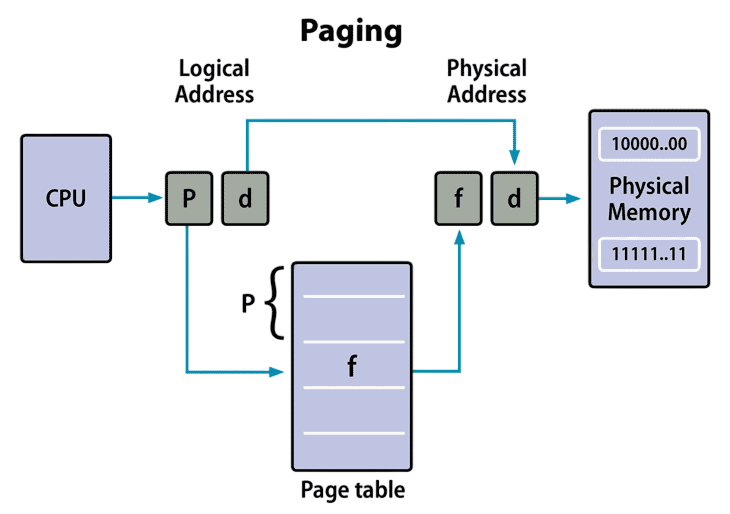
- Introduction to Memory Management
- What is Paging?
- Basic Terminology (Pages, Frames, etc.)
- How Paging Works
- Page Table and Its Role
- Advantages of Paging
- Disadvantages of Paging
- Page Replacement Algorithms
- Demand Paging
- Real-World Use Cases
- Conclusion
Introduction to Memory Management
In modern operating systems, memory management plays a crucial role in ensuring the efficient and safe execution of processes. Paging in Operating Systems ensures system stability, performance, and multitasking capabilities. While it introduces overhead through page tables and potential performance hits due to page faults, these are well-managed by modern systems through techniques like demand paging and efficient replacement algorithms a systems-level optimization approach echoed in Web Developer Training, where learners master responsive layouts, UX principles, and full-stack logic to build efficient, scalable web applications. Understanding how low-level system mechanics influence high-level design helps developers create robust digital experiences. One of the key techniques used in memory management is Paging in Operating Systems. Paging in Operating Systems addresses the issues of memory fragmentation and process isolation, allowing operating systems to manage memory dynamically and efficiently.
To Earn Your Web Developer Certification, Gain Insights From Leading Web Developer Experts And Advance Your Career With ACTE’s Web Developer Courses Today!
What is Paging?
Paging is a memory management scheme that eliminates the need for contiguous allocation of physical memory. Instead, both physical and logical memory are divided into fixed-size blocks. The blocks in logical memory are called pages, and those in physical memory are called frames. In programming, control flow mechanisms like Break, Continue & Pass Statements in Python help manage how data moves through these structures, influencing how memory is accessed and utilized. Paging allows the operating system to store parts of a program in non-contiguous frames, which makes better use of memory and reduces fragmentation. This technique helps in isolating the address space of different processes and in implementing virtual memory. With paging, programs can execute even if their complete data is not present in the main memory, thus facilitating multitasking and memory protection.
Basic Terminology (Pages, Frames, etc.)
Before diving deeper into how paging works, it’s essential to understand some basic terminology:

- Page: A fixed-size block of logical memory used by the process.
- Frame: A fixed-size block of physical memory used by RAM.
- Page Table: A data structure used by the operating system to map pages to frames.
- Page Number: The index number of a page in logical memory.
- Frame Number: The index number of a frame in physical memory.
- Offset: The location within a page or frame.
This terminology forms the foundation for understanding the paging process, and all memory-related actions within the system revolve around these components.
Would You Like to Know More About Web Developer? Sign Up For Our Web Developer Courses Now!
How Paging Works
Paging works by dividing a program’s logical address space into fixed-size pages and the physical memory into frames of the same size. When a program is executed, its pages are loaded into any available memory frames, not necessarily in a contiguous block. When a process needs to access data, the CPU generates a logical address. This logical address is split into two parts: the page number and the offset. In programming, understanding foundational elements like the Object Class in Java helps clarify how data structures interact with memory addressing and system-level operations. The operating system uses the page number to look up the corresponding frame number in the page table. Once the frame number is known, the actual physical address is calculated by combining the frame number and the offset. For example, if a logical address is 2048 and the page size is 1024 bytes, the page number is 2 and the offset is 0. The page table is consulted to find which frame contains page 2, say frame 5. Then the physical address is calculated as (5 * 1024) + 0 = 5120.
Page Table and Its Role
The page table is an essential component of the paging system. It acts as a lookup table maintained by the operating system to keep track of where each page of a process is stored in the physical memory. In programming, understanding the role of the Main Function in Python can help clarify how execution begins and how memory references are managed during runtime. Each entry in the page table contains:
- The frame number corresponding to a page.
- Additional control bits such as valid/invalid bit, read/write permissions, and access history.
Every time a process tries to access a page, the page table is checked to determine if the page is in memory. If the page is not found, a page fault occurs, and the operating system must fetch the page from secondary storage into RAM. The size of the page table depends on the number of pages in the logical address space, and managing this table efficiently is critical for system performance.
Are You Interested in Learning More About Web Developer? Sign Up For Our Web Developer Courses Today!
Advantages of Paging
Paging offers several advantages over other memory management techniques: it eliminates external fragmentation, allows non-contiguous memory allocation, and supports virtual memory systems benefits that reflect the structured optimization principles emphasized in Web Developer Training, where learners master front-end and back-end development, responsive layouts, and performance tuning. Understanding how low-level memory strategies influence high-level application behavior equips developers to build scalable, efficient web systems.
- Eliminates External Fragmentation: Unlike contiguous allocation, paging removes the problem of external fragmentation, making better use of memory.
- Enables Virtual Memory: Programs can exceed physical memory limits by loading only the required pages on demand.
- Efficient Multitasking: Since processes do not need contiguous memory blocks, multiple programs can coexist in memory more easily.
- Memory Protection: Each process operates in its own logical address space, preventing unauthorized access to other processes’ memory.
- Simplifies Allocation: Fixed-size pages and frames make allocation and deallocation simpler and faster.
Disadvantages of Paging
Despite its many benefits, paging also comes with some limitations:
- Internal Fragmentation: Fixed page sizes may lead to unused space in the last page, resulting in memory waste.
- Overhead of Page Table: Maintaining and accessing page tables introduces overhead, especially in large address spaces.
- Page Fault Overhead: Frequent page faults can significantly degrade system performance.
- Increased Access Time: Translating logical to physical addresses adds a level of indirection, slightly increasing access time.
- Complicated Management: Advanced techniques like demand paging or multi-level paging increase system complexity.
Page Replacement Algorithms
When a page fault occurs and memory is full, the operating system must decide which page to remove to make space for the new one. This decision is made using page replacement algorithms. Popular algorithms include:

- FIFO (First-In, First-Out): Replaces the oldest page in memory.
- LRU (Least Recently Used): Replaces the page that has not been used for the longest time.
- Optimal Page Replacement: Replaces the page that will not be used for the longest time in the future (theoretical best).
- Clock Algorithm: A practical approximation of LRU using a circular list and a reference bit.
Each algorithm has its own strengths and weaknesses, and the choice depends on system requirements and access patterns.
Demand Paging
Demand Paging is a more efficient form of paging where pages are loaded into memory only when they are required. Instead of pre-loading all the pages of a process, the operating system initially loads only a few essential ones. When a page that is not currently in memory is referenced, a page fault occurs. In programming, mastering initialization techniques like Init in Python & How to Master It helps developers understand how objects are prepared and memory is efficiently managed during runtime. The OS then loads that page into a free frame. This reduces memory usage and improves system responsiveness, especially for large applications that do not use all parts of their code simultaneously. Demand paging is widely used in modern operating systems as part of their virtual memory management.
Real-World Use Cases
Paging is used in various real-world systems and applications. In software development, understanding principles like Inheritance in Java helps clarify how modular design and memory management intersect, especially when building scalable, layered architectures.
- Operating Systems: All major OS like Windows, Linux, and macOS use paging to manage process memory.
- Databases: Large databases use paging to load data blocks into memory efficiently.
- Embedded Systems: Even resource-constrained systems use paging for optimized memory allocation.
- Virtual Machines: Paging enables multiple OS instances to share physical memory safely and efficiently.
The concept is so foundational that any modern computing device you use benefits from paging.
Conclusion
Paging in Operating Systems is a foundational concept in operating system design, offering a robust solution to the problems of memory fragmentation and inefficient memory usage. By breaking memory into manageable chunks and dynamically mapping logic to physical addresses, Paging in Operating Systems ensures system stability, performance, and multitasking capabilities. While it introduces overhead through page tables and potential performance hits due to page faults, these are well-managed by modern systems through techniques like demand paging and efficient replacement algorithms a systems-level optimization approach echoed in Web DevelopeTraining, where learners master responsive layouts, UX principles, and full-stack logic to build efficient, scalable web applications. Understanding how low-level system mechanics influence high-level design helps developers create robust digital experiences. A deep understanding of paging not only helps students and developers grasp OS internals but also empowers them to write memory-efficient applications. Whether you’re preparing for an exam, a technical interview, or simply seeking to improve your knowledge of how computers work under the hood, mastering paging is a must in your systems programming journey.



